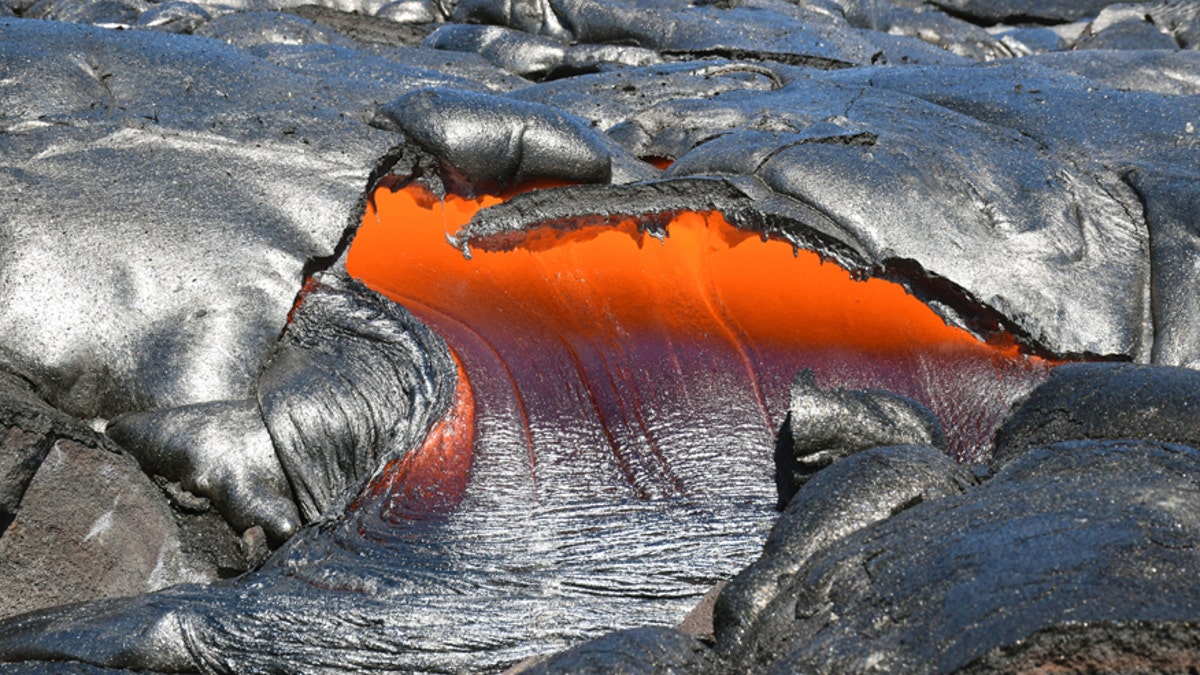Scientists collect lava samples from live volcanoes
Stunning images show geologists collecting lava from inside live Hawaiian volcanoes, benefiting mankind, but also putting themselves in harms way.
Stunning images show geologists collecting lava from inside live Hawaiian volcanoes, benefiting mankind, but also putting themselves in harms way.
Working for the United States Geological Survey (USGS), the geologists are gathering the lava to help understand "what's going on in a volcano's magma chambers," according to the USGS website. The USGS noted that if there is more magnesium than there is magma, the hotter the lava is.
The images were taken by the Hawaiian Volcano Observatory (HVO) in Kīlauea and Mauna Loa, two of Hawaii's most well-known volcanoes.
THOUSANDS DISPLACED AS PHILLIPINE VOLCANO ERUPTS AND LAVA FLOWS

A geologists takes samples from the KÄ«lauea volcano, which is the youngest and southeastern most volcano on the Island of Hawai. See Masons copy MNVOLCANO: These fearless geologists have been captured while carryinging out one of the the most dangerous jobs in the world - collecting lava from inside firey volcanoes. The workers can be seen in a series of captivating images going about their risky everyday work at the summit of live volcanoes in Hawaii. Their jobs are crucial to help gather information and understand patterns in volcanic activity. (© USGS, HVO / SWNS.com)
"HVO geologists also collect oblique aerial photographs and infrared images of lava flows during helicopter missions, and then use computer software to stitch them together to form large mosaics," an HVO spokesperson told SWNS.
The spokesperson added that the maps of the infrared images "provide remarkable 'pictures' of the many surface breakouts on an active flow, which allows better analysis of current flow behavior, as well as recent history and future advance of the flow."

The KÄ«lauea volcano, which is the youngest and southeastern most volcano on the Island of Hawai. See Masons copy MNVOLCANO: These fearless geologists have been captured while carryinging out one of the the most dangerous jobs in the world - collecting lava from inside firey volcanoes. The workers can be seen in a series of captivating images going about their risky everyday work at the summit of live volcanoes in Hawaii. Their jobs are crucial to help gather information and understand patterns in volcanic activity. (© USGS, HVO / SWNS.com)
There are six active volcanoes in Hawaii, all with distinctive characteristics. Kīlauea is the youngest and most active volcano on the Island of Hawaii, having erupted almost continuously since 1983. Mauna Loa is the largest volcano on Earth and has erupted 33 times since 1843, most recently in 1984 for a period of 22 days.
Hualālai is the third most active volcano on the Island of Hawai‘i, but it has only erupted three times in the past 1,000 years and eight times in the past 1,500 years. It most recently erupted in 1801. Mauna Kea is the highest volcano on the Island of Hawaii and most recently erupted between 4,500 and 6,000 years ago. It is partially covered by glaciers, making it the only known Hawaiian volcano to have this characteristic.
Lō‘ihi is the only known active Hawaiian submarine volcano and most recently erupted in 1996 during an earthquake. The summit is approximately 3,179 ft. below sea level.
Located on the Island of Maui, Haleakalā, most recently erupted between 400 and 600 years ago and has had at least 10 eruptions in the past 1,000 years.

